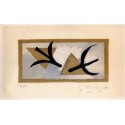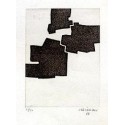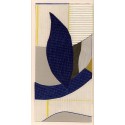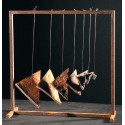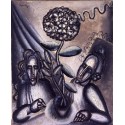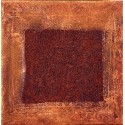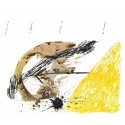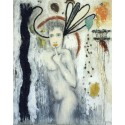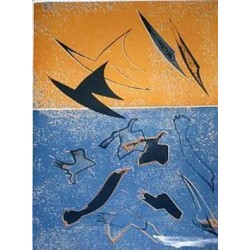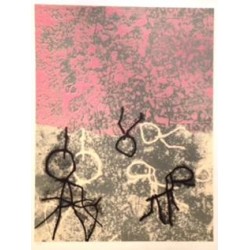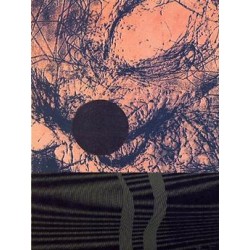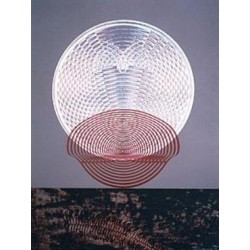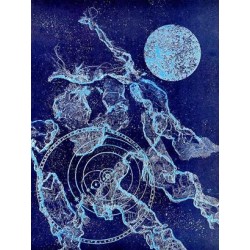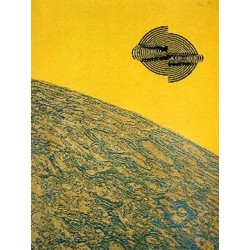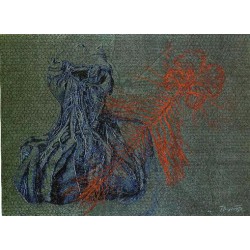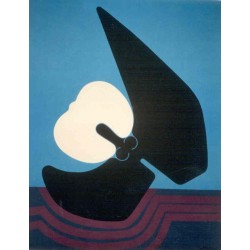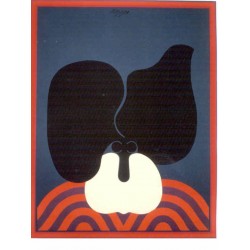Artists There are 22 products.
Subcategories
ALFARO Andreu
ANDREU ALFARO (València, 1929 - 13.12.2012).
He’s a sculptor of autodidactic formation. In 1958 he took part of the Parpallo group and he started participating in international competitions. He participated at the Spanish Pavilion in 1960 and 1995. His works can be seen at the most important international art fairs, as Köln, Basel, Dusseldorf, Paris, Madrid etc. Well-known galleries present his works. In Madrid: Galeria Metta, Galeria Uno, Galeria Alvaro Alcazar; Barcelona: Sala Gaspar & Galeria Joan Gaspar; Valencia: Galeria Temps; Köln: Gallerie Dreiseitel. Should be mentioned his monumental public sculptures, more than eighty with vocation to integrate in the public space as authentic collectives monuments: Germany: Köln, Maguncia, Frankfurt; United States: New York; Spain: Valencia, Burgos, Barcelona, Madrid, Gerona etc. He has been rewarded several times: Moulding Art National Reward, National Prize of Urbanism, Architecture and Public Work on 1991.
ARBOLEDA Alberto
ARBOLEDA ALBERTO (Popoyan, Colombia; 1925 – Brussel, Belgium; 2011).
He was a ceramist, sculptor and engraver. He initiated his studies in Colombia with the Spanish sculptor Jorge Oteiza. In 1952 he moved to Europe and started to study in the Artistic Museum of Rome with the sculptor Leoncillo Leonardi. In 1954, he collaborated in Paris with Guido Severini, a leading member of the Futurist movement. His artistic career leaded him to live in Spain, Germany, Denmark, Italy, Belgium, Sweden and Norway. His works are present at private collections in Finland, Sweden, Norway, Denmark, Austria, Belgium, France, Italy, Spain, Congo, Japan, Great Britain, the United States, Mexico, Panama, Peru and Colombia.
ARENYS Ricardo
RICARDO ARENYS GALDÓN (1914 – 1977).
Born in Barcelona, he practiced a skilled painting style with excellent control over means of expression. Around 1949 he started to specialise in the theme of horses. He participated in the Primavera Exhibition in 1934 and in the Nacional Barcelonesa in 1944. He won the third place medal at the National Exhibition in Madrid in 1945, and the second place medal at the National Exhibition of Fine Arts in Madrid in 1955. He held exhibitions at the Sala Gaspar in 1946, 1966 and 1977. His work has also been shown in Paris, Lisbon, London, Bilbao, and other major cities.
ARRANZ-BRAVO Eduardo
Eduardo ARRANZ-BRAVO (Barcelona, 1941).
Painter, engraver and sculptor. He studied in the Saint Jordi’s Fine Arts School and in the San Cugat del Vallés’s International School of Wall Painting (1959-1962). In the 70’s he met Rafael Bartolozzi with whom started to collaborate. During more than one decade they were realizing artistic projects that marked the history of Spanish contemporary art. Between these are standed out the paintings of the exterior fronts of the Tipel’s factory in Parets for the Vallès and the house for Camilo José Cela in Mallorca. His first work was near to the unformalism which he left in 1961. Since that moment his work moved towards the surrealistic world and the pop art’s esthetic. His work is present at the Museo Nacional Reina Sofía (Madrid); Contemporany art Museum (New York); the Museu de Arte de São Paulo (Brazil) and the Museo de Bellas Artes of Vitoria between others.
BARTOLOZZI Rafael
Rafael BARTOLOZZI (Navarra 1943- Vespella 2009).
He belongs to the generation of the 60s which brought together unequal artists inspired in the recovery of figuration and Pop Art. In 1962 started his studies in the Fine Arts's University in Barcelona and began to exhibit in Sala Gaspar.
In the beginning of his career he was fascinated for the abstractions of Millares, Saura and Tàpies, but since 1960s he turned back to the figurative art, becoming one of the best representative artists of Pop Art in Spain. In 1980s he sporadically turned to the informalism without forgetting the conceptual and objectual features of his work.
He was the director and the creator together with JOan Abelló of tha National Visual Poetry's prize Joan Brossa. His works are present in the most important museumns of Contemporary Art.
BRAQUE Georges
GEORGES BRAQUE (Argenteuil-sur-Seine (France) 1882 – París 1963).
French painter, engraver and sculptor, who with Juan Gris and Pablo Picasso was one of the forerunners of Cubism. In close collaboration with Picasso, Braque developed a new technique later known as Cubism. Both artists began to experiment with collage. This productive artistic union was broken when Braque enlisted in the french army at the beginning of I World War. From 1917 he restarted to work by himself, and at the end of the war he developed a more personal style.
BRINKMANN Enrique
ENRIQUE BRINKMANN was born in Málaga in 1938.
When he was 17 years old he started to paint as an autodidactic painter. In 1957 Brinkmann presented his first exhibition in Malaga and founded the Picasso Group, together with other painters from Malaga. He collaborated regularly with the poetry magazine “Caracola”, making illustrations. He travelled through Europe participating in several individual and collective exhibitions. In 1966 he came back to Spain, at the present he lives in Malaga, dedicating himself to painting, drawing and engraving, this last is very intensive field in his creation. In 1994 he received The National Award for Etchings from the Calcografía Nacional (Madrid).
The Latest Brinkmann’s period, shows his evolution away from figurative abstraction in paint and ink toward the adoption of metal net surfaces. Works from the late 1990s to 2002 display intense colour on the transparent net surfaces, but from 2003 purity of line becomes predominant.
Each one of paintings of this peculiar artist is a half-opened door. What we see through it, is also half-seen. It is a question of knowing how to see, and moreover, of intuiting what could be behind the shadows. The painting of Brinkmann reveals the ambiguity and the uncertainty of our time, but also something else, from the very bursting point of the moment of creation.
His works are present in many important public and private collection, such as: Albertina Museum (Viena), Museo Nacional Centro de Arte Reina Sofía (Madrid), The Fine Arts Museum (Bilbao), Museum of Modern Art (New York), Wallraf-Richartz-Museum (Cologne) etc.
CALDER Alexander
CASANOVAS Claudi
CLAUDI CASANOVAS (Barcelona, 1956).
He first studied for the theatre in Barcelona, then trained as a ceramist in Olot (Catalonia). He was a member of the Coure Potters’ Cooperative from 1978 to 1987. In 1985 he won de 2nd prize at the 43rd international Ceramics Competition in Faenza, Italy. In 1986 he won de Big Prize at the Vallauris Biennale in France. In 1992 he won first prize at the III International Ceramics Competition in Mino, Japan. Since 1986 he lives and works in Ridaura (near Olot). The ceramics-sculptures of Claudi Casanovas introduce into a geological landscape. They “seem” basalt, granite rocks, just extracted from the volcanic setting in which the sculptor works. A basic work is the “Monument to the War Defeat from 1939” in Olot, Girona.
CASTILLO Jorge
JORGE CASTILLO. Born in Pontevedra in 1933.
His family emigrated to Argentina in 1934 for political reasons and didn't come back to Spain until 1956.
He started as a technique drawer and at the same time he wrote poems. In 1946 published his first stories. From 1958 his work gained recognition thanks to Galeria Biosca from Madrid, and afterwards in Europe and New York. Nowadays his artistic creation can be found in different museums on the world from USA to Jerusalem.
This multidisciplinary artist combines with success the discipline of writing and painting in different techniques, as well as engraving and sculpture. Probably, his most famous work is a triptych in huge dimensions named "Palomares", related about an incident with an atomic bomb lost in the Mediterranean sea near with Palomares (Almeria) during north-american militar manoeuvres.
The sculpture in big format is exhibited in public places in different European cities.
CLARET Joan
JOAN CLARET (Barcelona, 1929-2014).
He studied architecture. He took part in the group called “Cero Figura” with Tharrats and Vilacasas, realizing publications and expocitions at Sala Gaspar where he showed his works in 1959, 1960, 1961, 1966, 1972, 1976. Also he took part in several collective expositions in different european cities. In 1995 he exposed at the Joan Gaspar Gallery (Barcelona).
At his beginnings, his art was abstract and geometric. Klee, Mondrian and Kandiski were his masters. Firstly, he chose plane forms, then he wanted to reach profundity. So he began to use geometric volumes. Later he approached a curve line to give a movement. It was the same change with colors: white, black and grey, then light blue and at last red, yellow using a blending. He worked with oil and watercolors.
CLAVÉ Antoni
ANTONI CLAVÉ i SANMARTÍ (Barcelona 1913- St. Tropez 2005).
Antoni Clavé is one of the most important artists in the Catalan Contemporary Art. He developed his artistic activity in almost every field: painting, engraving, lithography, collage, sculpture and photography. He studied in Barcelona and started his career as a designer for articles and cinematographic posters.
He participated in the Spanish Civil War with republican army and in 1939 he moved to France where he started to produce lithographs. This activity kept him in touch with publishing world. He illustrated many books, between them “Carmen” from Merimée (1946), "The Queen of Spades" from Pushkin (1946). In 1942 he met Picasso and decided to focus his work towards still life and urban landscape tending to the abstraction. At this moment he was an international artist. In 1954 Clavé decided to dedicate himself only to paint and started to include in his work strange iconography of medieval figures, bearded kings and dolls. The evolution to abstraction was unstoppable: the content was losing importance and the texture and visual aspects of atmosphere and background started to be essential.
In 1956 Clavé began to use the collage as a painting technique and the composition scheme incorporating themes typical of informalism. This year he presented his work in Barcelona, from that moment his exhibitions were regular. Besides painting he worked with sculpture, tapestry and set design for theatre, ballet and opera: “Carmen”, “The House of Bernarda Alba”, “The Marriage of Figaro”…
Some prizes: Venice Biennale (1958), Sao Paulo Biennale (1957), Tokyo Engraving Biennale (1958). In 1978 Georges Pompidou Centre in Paris organized Clavé’s individual exhibition. In 1984 his work was a central theme of a Spanish pavilion in Venice Biennale.
Antoni Clavé was a very close friend of the Gaspar family, and during the second part of XX century exhibited many times in Sala Gaspar as well as they collaborated in many Clavé’s exhibition around the world. Joan Gaspar junior, a dear friend from Clavé for more than 50 years, has presented several exhibitions in Galeria Joan Gaspar.
CHILLIDA Eduardo
EDUARDO CHILLIDA (San Sebastián, 1924 – 2002).
In 1943 he starts architecture’s studies that left three years later to draw at Madrid’sThe Fine Arts Circle. His first sculptures are made in this time. He lived some time in France, first in Paris and later in Villaines-sus-bois in the South. In 1951 he came back definitively to Euskadi . He worked the sculpture in all sizes and all the materials: wood, plaster, terra cotta, porcelain, alabaster, granite, concrete, steel, iron, bronze, etc. He cultivated the engraving: etching, litho collage and xylography
GUDIOL Montserrat
MONTSERRAT GUDIOL (Barcelona 1933).
Initiated by her father Josep Gudiol, one of the most important experts in Catalan’s Art, she grows up in a climate where art was a daily factor. From the beginning she worked hard to have a personal pictorial style. In 1950 she presented her first portrait’s exhibition; follow by other national and international shows. Her first exhibition in Sala Gaspar took place in 1962 then in 1965, 1967, 1976, 1978, 1980, 1982, 1986, and 1990. Her international projection initiated in 1964 in USA with an itinerary exhibition which lasted until 1966, A Modern Spanish Paintings: Seven Catalonian Artist. She has works in the Museums of Modern Art of: Barcelona, Madrid, Bilbao, EUA, South Africa and Reial Academia de Belles Arts de Sant Jordi, Barcelona.
HUYNH Jean-Baptiste
JEAN-BAPTISTE HUYNH (Châteauroux, 1966).
Vive y trabaja en París, Francia. Fotógrafo autodidacta e independiente, el mismo produce las ediciones de sus obras. La personalidad de este joven artista mitad francés y vietnamita, se puede resumir en dos palabras: perfeccionismo y determinación. Su habilidad procede de una percepción y claridad de visión conjuntas. Las fotografías de Jean-Baptiste Huynh son la consecuencia de una altísima sutil destilación de forma y luz. La esencia resultante es tan pura que el único trazo de su creación es la técnica sublime.
IBARZ Miquel
MIQUEL IBARZ (1920 Mequinenza – 1987 Barcelona).
His family soon moved to Barcelona At the end of the Civil War he confirmed his vocation and studied at the Fine Arts school. In 1954 was his first individual show. American and Dutch galleries acquired Ibarz’s paintings initiating an international collecting. A trip to Italy in 1957 impressed him motivating a more sensual and colorful painting. In 1959 Sala Gaspar presented his first individual exhibition. Since them they represented his works: 1961, 1966, 1972, 1977, 1979, 1984 ... He developed the engraving field such as the etching and lithography.
ISERN Jordi
JORDI ISERN (Barcelona, 1962).
In 1985 Isern was awarded with a Generalitat Plastic Arts’s grant and in 1986 another one from the Güell Foundation. Since 1988 to 1999 he dedicated part of his time to the theoretical investigation. From 1989 to 1993 he travelled across Asia and finished his Phd The emptiness in the occidental painting, an approximation to the Buddhist aesthetics. He defined his work as tracks, signs, painting as body’s archaeology and at the same time as magical and intangible writing. The body as a map, a hieroglyphic which hides the body’s memory. He looks forward a confrontation between the material, obvious and visible with the immaterial, unobvious and invisible.
JACOBS Marion
MARION JACOBS (1943 Aachen, Alemanya – 2002 Köln, Alemanya).
After her studies in Art History she specialized in book trading. She created her first collage in 1977 and two years later she presented her first exhibition in Essilingen, Neckar. On the following years she exhibited in several galleries, mainly in Dreiseitel Gallery in Köln and Joan Gaspar Gallery in Barcelona. In her works we can find the reminiscence of the biggest figures of collage, such as Karl Schwiters, Max Ernst and the artists of the Berlin's dadaism: Hannah Höch and Raul Hausmann.
At the begining, Marion Jacobs experienced the collage for "the pleasure of confusing" and "the happiness of playing" but soon she realized her strength capacity of expression. These portraits don't correspond to a specific reproduction but they have the universal caracter of african masks.
JUBANY Josep Lluís
JOSEP LLUÍS JUBANY (Barcelona, 1948).
Versatile creator, designer, painter, Jubany has a long artistic career, whose path is inseparable from other catalan artists active in the 1960’s. He takes part in a generation marked by experimentation. Trained as graphic designer at the innovative Escola Eina, in the 1970’s he took part in Estampa Popular beside Albert Ràfols – Casamada, Maria Girona, Josep Guinovart and Joan Hernández – Pijuan. In 1967, he founded the artistic collective Grupo A, with Ramón Herreros, Jordi Morera and Alexander Tornabell. These is the decade when his own artistic style is defined, dominated by graphism, geometric order and depuration of form and color. His interest in cinema led him to film the movie “Imatge” in 1973 as well as to start a collaboration with the Filmoteca de Catalunya and several avant-garde magazines as Destino, L’Art Voltaic and Àmpit.
KRÄHENBÜHL Etienne
ETIENNE KRÄHENBÜHL (Vevey, 1953).
After two years at Lausanne Art School, Etienne Krähenbühl set off for Barcelona and Paris. Later he set up first in Agiez and then in a workshop in Romainmôtier (Switzerland) where he devoted his time to sculpture. Krähenbühl developed an autodidact way of metal’s modelling. The corrosion and oxidation made him to look for another Scientifics fields. A meeting with the physic Rolf Gotthard made him to discover the incredible shape-memory alloy and superelastic metals. It was a collaboration “which moving between science and poetry, delicacy and monumentality, gravity and lightness, led the artist to “test the limits of materials to bring out their movements and sounds from the depths of the earth” (Françoise Jaunin).
His work is always dynamic and invites a spectator to contemplate the movement, to listen different sounds, to touch and to play with it. It is, at the same time, monumental and fragile.
One of the central themes of Krähenbühl’s art is the time, the artist’s witness or his expression, the materialisation of his memory.
“For several years I have been preoccupied with the temporality of matter and the alteration that appear as matter endures its sojourn through time. Corrosion, wear, oxidation and traces of rust are my tools. Matter is fundamental for me; it reflects my thoughts and discoveries, it connects me to the external. It is a universe of expression and poetry while also representing weight and tragedy. To create in metal, to let it express its own voice, is a work of ceaseless struggle, wonder and play”. (Ettienne Krähenbüh)
He had individual exhibitions in many museums and galleries in France, Switzerland, Spain, Germany and USA.
LLOVERAS Frederic
FREDERIC LLOVERAS HERRERA (1912-1983).
Born in Barcelona he studied at the Cercle Sant Lucas and in the Sant Jordi School of Fine Arts. He began to paint with oils, and then from 1936 to 1939 he dedicated himself to drawing, to which he would incorporate colour, and finally ended up specialising in watercolours. He held exhibitions of both oil and watercolour paintings. He participated in the National Exhibitions of 1942, 1944 and 1948, as well as in the Tardor exhibitions in 1951 and 1952. In 1971, he held a solo exhibition at the Sala Gaspar. His work is classified as postimpressionist.
LLOVET Ramón
RAMON LLOVET (Barcelona, 1917 – 1987).
He started his studies of painting at the age of 14 year in the “Escola de Belles Arts Llotja de Barcelona and at the L’Athenos. After a period studying materials and colours used by the great painters he did complemented with studies of scientific experiments at the Institute Max Doerner in Munich. Accepted by the Catalan Vanguard he studied the Catalan Popular Art and exhibited in Sala Gaspar in 1958 and later in 1962, 1965, 1968, 1974 and 1977. Since the beginning he was interested in poetry and philosophy, later in oriental religions.
MASSON André
ANDRÉ MASSON (Balagny-sur-Thérain, 4 de enero de 1896 - París, 28 de octubre de 1987).
Estudià art a Brussel•les i s’instal•là a Parísel 1920. El 1922 signa un contracte amb el marxant Daniel-Henri Kahnweiler, galerista de Picasso, Gris, Léger, Manolo, Laurens i Togores, entre d’altres. El 1924, entra en contacte amb el grup surrealista encapçalat per l’André Breton. Amic de Miró s’endinsaren en la pintura automàtica i amb unes grafies quasi abstractes assentaren la base del primer surrealisme. Cap al 1929 es distancia de Breton, però cap el 1937 es reconcilien i Masson tornarà a formar part del grup surrealista ortodox. El 1934 visita Espanya i s’instal•la una temporada a Tossa de Mar.
El 1937 torna a París i quan esclata la Segona Guerra Mundial, es trasllada als Estats Units, Exercirà una notable influència entre els artistes més joves, que a la llarga, crearan l’expressionisme abstracte: Aschille Gorki, Jacson Pollock, Willhem de Koening ... Finalitzada la guerra torna a París. El 1950 té lloc la primera exposició retrospectiva juntament amb Alberto Giacometti, al Kunstmuseum de Berna. El 1954 Gran Prix National des Beaux Arts a Paris. El 1955 participa en la primera Documenta de Kassel. El 1958 retrospectiva de la seva obra gravada a l’Albertina Museum de Viena. el 1964 participa de nou en la Documenta de Kassel i dues grans retrospectives a l’Acadèmia der Kunst de Berlín i al Stedelijk Museum d’Amsterdam. El 1972 participar a la Biennal de Venècia, el Museu d’Art Modern de la Ville de París organitza una antològica dels seus dibuixos i el mateix any el MOMA de Nova York celebra una gran retrospectiva. El 1978 exposa a la Kunsthalle de Bremen. Dues grans antològiques a Espanya, una a Barcelona el 1985 a La Caixa i una altra a Madrid, al Museu Nacional Centre d’Art Reina Sofía el 2004. Masson continuarà pintant fins al final. Mor a París el 1987, a l’edat de 91 anys.
MIRÓ Joan
MITORAJ Igor
PICASSO Pablo
PABLO RUÍZ PICASSO (Malaga, Spain 1881 – Mougnis, France 1973).
Pablo Ruiz Picasso is one of the most important and influential artist of XX century, his art has impacted the development of modern and contemporary art.
He was born in Malaga, on October 25th, 1881, being the first-born son of José Ruiz Blasco, painter, professor at the School of Fine Arts and curator of the Municipal Museum. The father’s influence was essential in the initiation of young Picasso into the art. During some years he lived in Corunna, Barcelona and Madrid, where he was studying in the San Fernando Academy of Fine Arts. Last years of XIX and the begging of XX century he realized many travels from Barcelona to Paris and in 1904 he moved to the French capital definitely.
Picasso's work is often divided into periods. While the names of many of his later periods are debated, the most commonly accepted periods in his work are: the Blue Period (themes of poverty, loneliness, and despair), the Rose Period (pleasant themes such as carnival performers, harlequins, and clowns), African-influenced (paintings that signals the nascent stages of Cubism), Cubism (Analytic Cubism (1910-1912), which techniques were developed by Picasso and George Braque, and Synthetic Cubism (1912-1913) characterized by including new elements such as cloth or grain of wood), Neoclassical Period (mythological images such as centaurs, minotaurs, nymphs, and fauns), Surrealism (pictures of morphed and distorted figures) and Expressionism (expressive qualities of bold colours and gentle curves).
Pablo Picasso and Gaspar family met in 1955 and from this moment Sala Gaspar transformed into the most important centre of dissemination of Picasso’s art in Spain. All organized exhibitions (in total 10 during 1960’s – 1980’s) had a great success in Barcelona.
During all his life Picasso developed different graphic techniques, producing a huge number of etchings, engravings and lithographs.
Joan Gaspar is a member of patronage of The Picasso Museum in Barcelona.
ROGER Suzanne
SUZANNE ROGER (Paris, 1898-1986).
She belongs to the Kahnweiler’s group of artist in the twenties of last century. She was the only artist-woman in the gallery. She was a young and cultivated painter; she studied in the Lycée Racine and later in the Académie Ranson. Was married with the painter and sculptor André Beaudin. When in 1928 they meet Francisco Bores, a deep relationship was born. An interrelation between the three painters’ stylistic evolution took place.
In 1923 she had her first individual exhibition in the Galerie Simon. It did followed other ones in Galerie Louise Leiris until 1979.The second exhibition had a great success; collectors as Edmond Jaloux, Roger Duthilleul or Léonce Rosenberg, acquired works for their collections. Some of her best paintings were inspired with the Spanish Civil War. She showed drawings in la Maison des Beaux-Arts(1945) and etchings and litographys in the Galerie Jean Aubier (1948). From 1937 she starts participating in international exhibitions: Sweden, Germany, Switzerland, England and USA. In 1986 the Galerie Leiris organised a posthumous homage-exhibition. To commemorate her birth’s century in 1998, another exhibition was organized. Suzanne Roger as well illustrated works from Max Jacob and Tristan Tzara.
ROUX Gaston-Louis
GASTON-LOUIS ROUX (Provins, 1904 – Paris, 1988)
Since 15 years old he studied at Académie Ranson, where he had as teachers Maurice Denis and Paul Sérousier. He worked on the illustration for “Les souvenirs d’egotisme”, from Stendhal (1924) and “Les exploits d’un jeune Don Juan”, from Apollinaire (1926).
When he was 23 he was hired by Daniel Henri Kahnweiler and in 1929 he had his first exhibition with a great success. Roux’s work often is divided in two parts: the surrealistic period and the figurative one. His first period is very interesting. Nevertheless his paintings have been quite hiding for more than 50 years and no-information left his work confined.
In 1950 he decided to return to the figurative painting, fact that ends his relationship with Kahnweiler.
Roux had several individual shows as all Kahnweiler’s artists: Pablo Picasso, André Masson, George Braque, Juan Gris, Fernand Léger, André Derain, etc. His work had appeared in many Roger Vitrac’s articles and in several Cahiers d’Art publications.
Galeria Joan Gaspar discovered this artist in 2001 in Paris and since that moment the gallery started to play the role of the principal centre of dissemination for Roux’s art in Spain. The exhibitions in 2001 and 2005 were significant approach the society to the work of this artist. Today many of his works are present in Spanish and international collections.
SAMPOL Concha
CONCHA SAMPOL (Palma de Mallorca 1952).
She studied in Art School at Barcelona’s University, Design in BCD, Ceramic in Caolí and Engraving in Barcelona’s University. The first one individual shows were: 1996 S’horabaixa in Galeria Interior, Girona, Spain & 1997 Somnis in Gynaikos, Barcelona. Her first one show in Galeria Joan Gaspar-Barcelona took place in 1997 New-Art . In 1998 Pinturas-Dibujos . 2001 Chiado and 2004 Geologías in Galeria Joan Gaspar-Barcelona & Madrid. Also he was present in Artefiera Bologna, Italy 2003-2004 and ARCO Madrid, Spain 2000-2004-2005.
TÀPIES Antoni
ANTONI TÀPIES (Barcelona, 1923-2012).
Born in Barcelona in 1923, Tàpies started his artistic run during a long convalescence due to a serious sickness. The increasing interest in drawing and painting pushed him to leave academic studies. On the 1940’s he alredy exposed works with a strong personality, outstandig in the contemporary artistic panorama. In 1948, he co-founded the magazine “Dau al Sel”. Influenced by Miró and Klee, he intensified the iconographics elements and the magical field. Slowly, he started to absorbe geometrizing elements and color studies that lead him to an interest for the materic, resulting intense weaving canvas with wide possibilities of expression and communications. With those works, in the middle of 1950s, Tàpies reached international recognition.
Since 1960s, he added new iconographic elements (marks of writing, anthropomorphic elements, footsteps and signs reporting to Catalunya’s situation), technical procedures (new surfaces, use of everyday objects and varnish). The artistic language of Tápies has develop since then and the result is a diversified and great plastic production admired around the world.
THARRATS Joan-Josep
JOAN-JOSEP THARRATS (Girona 1918 – Barcelona 2001).
Painter, engraver as well as an expert on Spanish Art. Studied in Beziers and Barcelona (1932-1935). He initiated as painter in 1945 with pastel drawings clearly influenced by Toulouse-Lautrec and Van Gogh. His first abstract works in 1946 had influences of Mondrian and Kandinsky. In 1948, he was part of the group of Dau al Set, at that time he immersed in the surrealism’s and magic abstraction, until he moved to informality. As engraver aportó el proceso de la maculatura y como literario published “Antoni Tapies o el Dau Modern de Versalles”(1950) Several articles in the magazine Dau al Set (1948-1956).
In 1947 he met the painters Joan Ponç, August Puig and the poet Joan Brossa; later on he met Modest Cuixart and Antoni Tapies. All together they founded the group “Dau al Set” as well as the magazine with the same name where he wrote articles and was the edition’s director until the closed it in 1956. His firs own man show took place at the Galerias Jardin, Barcelona (1950) and at the Sala Gaspar: “Collages” 1954; “Maculatures” 1955; “Joies i Escultures” 1956; and 1957, 1958, 1º960, 1963, 1967, 1973. His international projection was strong in Europe as well as in USA, exhibiting in one man shows and in collective’s exhibitions. His works are present in the Tate Gallery-London, Museum of Modern Art-New York, Salomon Guggenheim Museum-New York, Museo Nacional Centro de Arte Reina Sofia-Madrid, Museo de Arte Moderno-Barcelona as well as in several important Museums of Modern Art.
TODÓ Francesc
FRANCESC TODÓ (Tortosa, 1922).
Todó moved to Barcelona when he was young. In 1940 he started his studies in a workshop Sainz de la Maza and later in Sant Jordi’s School of Fine Arts. In 1946 and 1948 he exhibited in Sala Vinçon in Barcelona. From this moment his exhibitions were frequent in many Spanish and foreign cities. In 1954 he got a grant for trip to different countries of Europe: France, Belgium, Holland and England. He was a professor in University of Los Andes in Bogotá till 1972. Later he decided come back to Barcelona where he continued to work in this field. In 2001 he was awarded the St. George’s Cross as recognition of his professional trajectory.
TOGORES Josep de
JOSEP DE TOGORES (Sardañola del Vallés, Barcelona, 19 de julio de 1893- Barcelona, 17 de junio de 1970).
Togores arrives to Paris in 1913. He’s a recognised painter in Barcelona. The First War made him come back to Barcelona and in 1919 he returns to Paris. In 1920 he met Kahnweiler and a year later he signs a contract with him. This relationship will last until 1931. In 1922 he has the first one individual exhibition, presented by Max Jacob, with a great success. The Togores’ works has always been divided in two antagonistic blocks: figurative-realist 1920-1927 and abstract–surrealist 1928-1931. When he ends his relation with Kahnweiler he returns to Barcelona forever. His works will be showed in Sala Parés and the Gallerias Joan Gaspar-Barcelona (1994-1995) and Madrid (2006). Art dealers as Albert Flechtheim in Düsseldorf, Germany and Kahnweiler in Paris, France make known his work as well as the André Masson, Henri Laurens, Gaston-Louis Roux and Elie Lascaux. Their work was published in prestigious Art Magazines and was exhibited in European capitals as well as in cities as Tokyo or New York. He had a good friendship with Aristides Mallol and Max Jacob.
UCLÉS Josep
JOSEP UCLÉS (Badalona, 1952 – La Roca del Vallès, 12 de setembre).
Spanish painter and graphic artist, Josep Uclés is one of the most representative artists in the European New Figuration. An outstanding fact of his artistic career is the participation in the famous exhibition of catalan contemporary art “Seny i Rauxa” in 1978 in Paris, at the Center George Pompidou. The plastic and esthetic singularity of his creations, with his critic and independent personal temper, produced an unmistakable mark that keep the artist apart from temporary styles and ephemeral artistic market. His work, at the beginning obscure, mysterious and with an incisive social criticism, has evaluated a keen irony, more colorfull and poetic, where the human figure is always the main point.
VILATÓ Javier
JAVIER VILATÓ (Barcelona, 1921-París, 2000).
Immersed since childhood in the world of Art, Javier Vilató, Picasso’s nephew (son of his sister Lola and Joan Baptista Vilató, a catalan neuropsychiatrist), in Paris deeply absorbed a new way of life and a new feeling about art that he proposed in its works, refusing the estabilished parameters, while searching for his own identity. If a characteristic marks the life and the art of Vilató, beyond his attraction for mediterranean light shown in the use of colors, it’s his interest, or rather, his look that reveals his surrounding, often very close to his intimacy. For this reason, Vilató was a great portrait painter during all his lifetime, until the last period in which he intensely worked in the sculptural portrait. His subjects are the beloved women, his sons, his friends as well as his dogs, his horses – animals he shared his house with – and even simple, daily objects; a choice reflecting his free, lively and pasionate point of view.
VILATÓ Xavier ("Xavier")
"XAVIER" (XAVIER VILATÓ) (1958, Boulogne-sur-Seine).
Xavier Vilató was born in 1958 in Boulogne-sur-Seine, of a French mother and a Spanish father. Coming from a family linked to the world of art, he learned early the techniques of engraving and painting. In 1975 he began his artistic career exposing in various European countries.
He works simultaneously with painting, ceramics, engravings and from 2006 with films production. His work is divided into many series.
He realized more than 30 individual exhibitions in France and abroad, including two important retrospectives in 2005 at the Picasso’s Native Casa Foundation in Malaga and the Museum of Fine Arts of Cambrai (France) in 2006.
In 2013 his work was presented at Barcelona’s Museo Marès during six months (The Incredible Story of the Seed of Love, a multidisciplinary project built around a short film).
His work is presented in numerous private and public collections in France, Spain and Portugal, as the National Museum and Art Centre Reina Sofia in Madrid, Actilibre Foundation in Madrid, Paris Doucet Library, the Bibliothèque Sainte-Geneviève of Paris, the Bibliothèque Nationale de France, the Museum of Contemporary Spanish Engraving of Marbella, the Fata Morgana Foundation, the Museum of Graphic Arts of Barcelona, General Council of the Jaén Region, CEPSA Collection, Fundação António Prates.
VILADECANS Joan-Pere
JOAN PERE VILADECANS (Barcelona, 1948).
At a young age Viladecans had to stop his studies and began to work. He was interested in poetry and plastic arts, which did eventually lead him to discover painting. He held his first individual exhibition at Sala Gaspar (Barcelona) in 1969. The success was so important that during next two decades he exhibit 6 times at this gallery.
Around the same time, his art became known in Germany through the Dreiseitel Gallery in Cologne, with exhibitions in 1971, 1974, 1976, 1980 and 1990. He had a close friendship with many representatives of Catalan culture as a poet Salvador Espriu and a multidisciplinary artist Joan Brossa. In the 1970s and 1980s his work was shown in galleries in Europe and USA.
His style changed in 1990, when he began to create pieces on paper with many different materials like India ink, oxides, resin, fish blood, sea water, iodine and squid ink. In 1994 and 1996 he held two exhibitions at Galeria Joan Gaspar. These were followed by two itinerant exhibitions: “A natural history (1998 – 2000)” exhibited in the Zoological Museum of Barcelona, Foundation “Obra Social La Caixa” in Manresa and the Chateau de Bellegarde, Le Perthus, France; and “365 days of Viladecans (1999 – 2000)”, which was shown at the Art Centre “Santa Mònica” in Barcelona and in the Cultural Centre “Conde Duque” in Madrid. In 2007 he exhibited at the Galeria Joan Gaspar in Barcelona and Madrid.
Viladecans’s works are in many private collections in Spain, England, USA, Sweden, Germany and different Latin American countries.
Lithography Tharrats 843
GRAPHIC WORK Artist: Joan Josep Tharrats. Media: color lithography and collage. Year: 1973 Size: paper 75x56 cm. Edition: 90 pieces signed and numbered.
165,29 €In StockTharrats "Genesis nº7 (sixth day)"
GRAPHIC WORK Artist: Joan Josep Tharrats. Media: color lithography. Year: 1977 Size: paper 75x56 cm. Edition: 90 pieces signed and numbered.
165,29 €In StockTharrats "Homenatge a Vessalius"
GRAPHIC WORK Artist: Joan Josep Tharrats. Media: color lithography. Year: 1975. Size: paper 56x75 cm. Edition: 75 pieces signed and numbered.
500,00 €In StockTharrats "Homenatge a Galileo Galilei"
GRAPHIC WORK Artist: Joan Josep Tharrats. Media: color lithography. Year: 1975. Size: paper 75x56 cm. Edition: 75 pieces signed and numbered.
500,00 €In StockTharrats "Homenatge a Isaac Newton"
GRAPHIC WORK Artist: Joan Josep Tharrats. Media: color lithography. Year: 1975. Size: paper 75x56 cm. Edition: 75 pieces signed and numbered.
500,00 €In StockTharrats "Homenatge a Albert Einstein"
GRAPHIC WORK Artist: Joan Josep Tharrats. Media: color lithography. Year: 1975. Size: paper 75x56 cm. Edition: 75 pieces signed and numbered.
500,00 €In StockTharrats "Homenatge a Teihard Chardin"
GRAPHIC WORK Artist: Joan Josep Tharrats. Media: color lithography. Year: 1975. Size: paper 75x56 cm. Edition: 75 pieces signed and numbered.
500,00 €In StockTharrats "Homenatge a Hipòcrates"
GRAPHIC WORK Artist: Joan Josep Tharrats. Media: color lithography. Year: 1975. Size: paper 56x75 cm. Edition: 75 pieces signed and numbered.
500,00 €In StockARBOLEDA Alberto. Lithograph №3
Graphic work Artist: Alberto Arboleda Title: №3 Year: - Media: Original colour lithograph Size: 105x62 cm. Edition: 75 copies, numbered and signed
148,76 €In StockARBOLEDA Alberto. Lithograph №7
Graphic work Artist: Alberto Arboleda Title: №7 Year: - Media: Original colour lithograph Size: 105x62 cm. Edition: 75 copies, numbered and signed
148,76 €Out of stockARBOLEDA Alberto. Lithograph №10
Graphic work Artist: Alberto Arboleda Title: №10 Year: - Media: Original colour lithograph Size: 105x62 cm. Edition: 75 copies, numbered and signed
148,76 €In StockCHILLIDA Eduardo. "Zeihartu IV" (Shear)
Graphic work Artist: Eduardo Chillida Title: "Zeihartu IV" (Shear) Year: 1973 Media: Etching Size: paper 79x60,6 cm, plate 23,8x29,7 cm. Edition: 25/50, numbered and signed
5 000,00 €Out of stock






